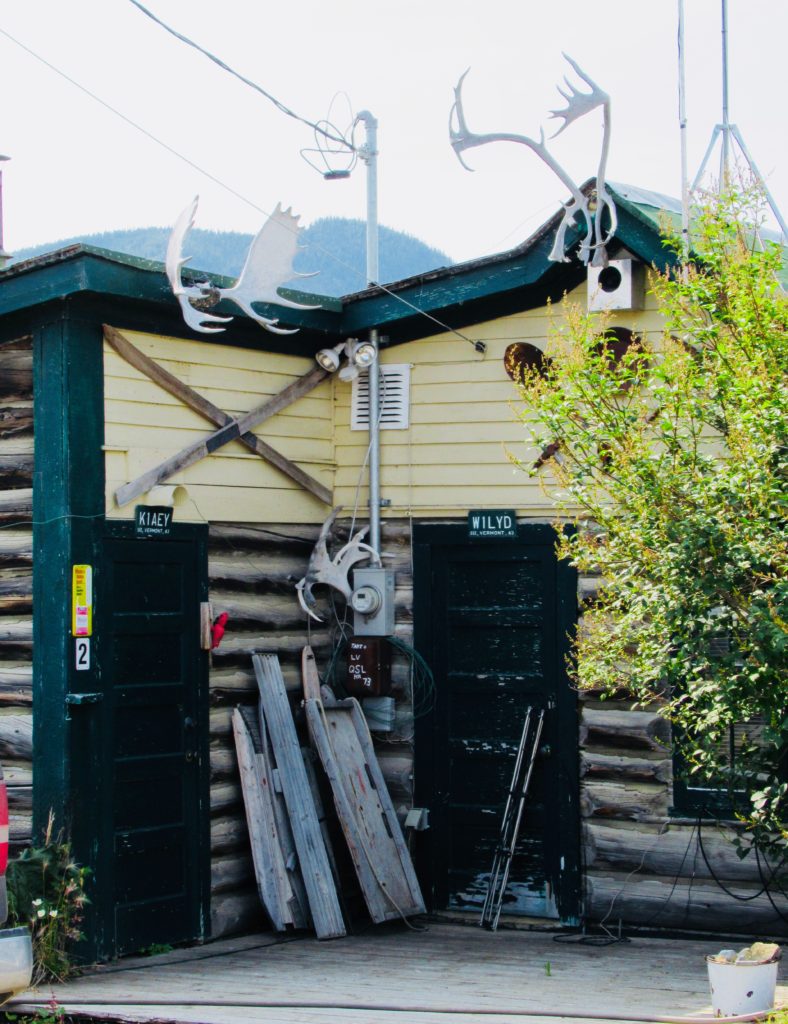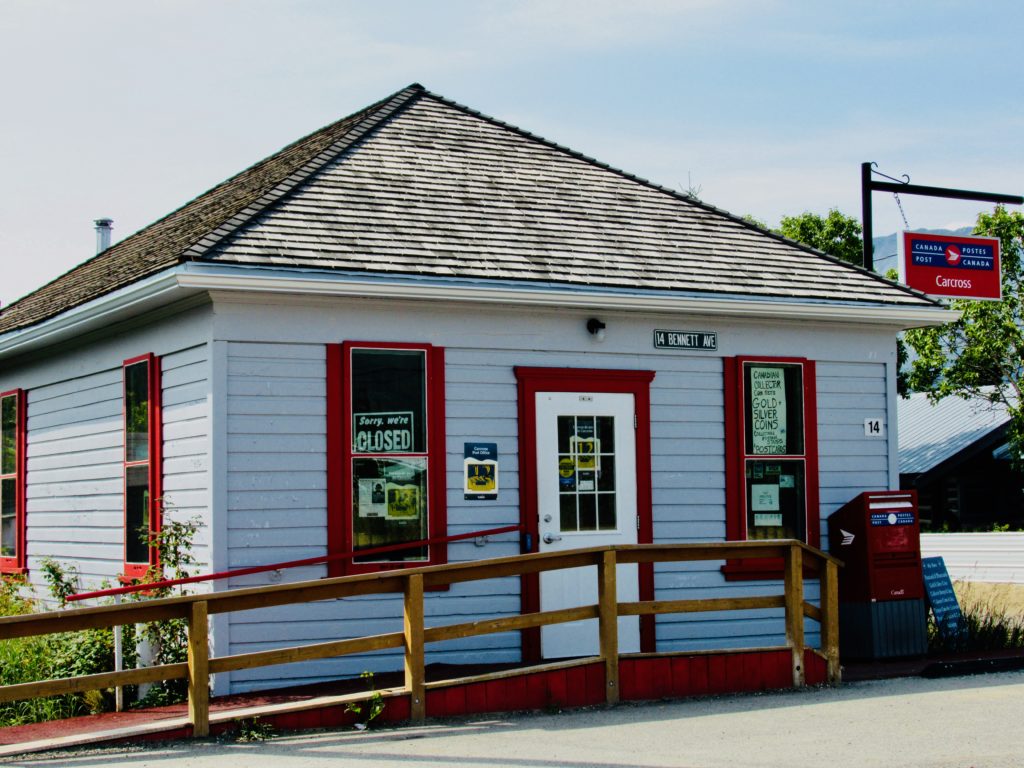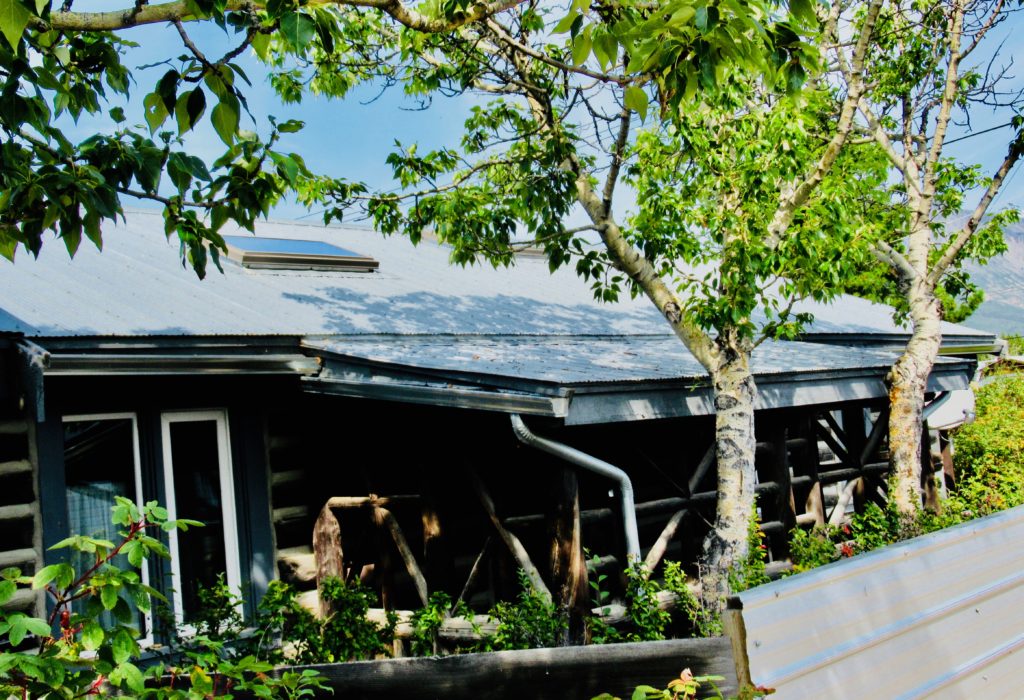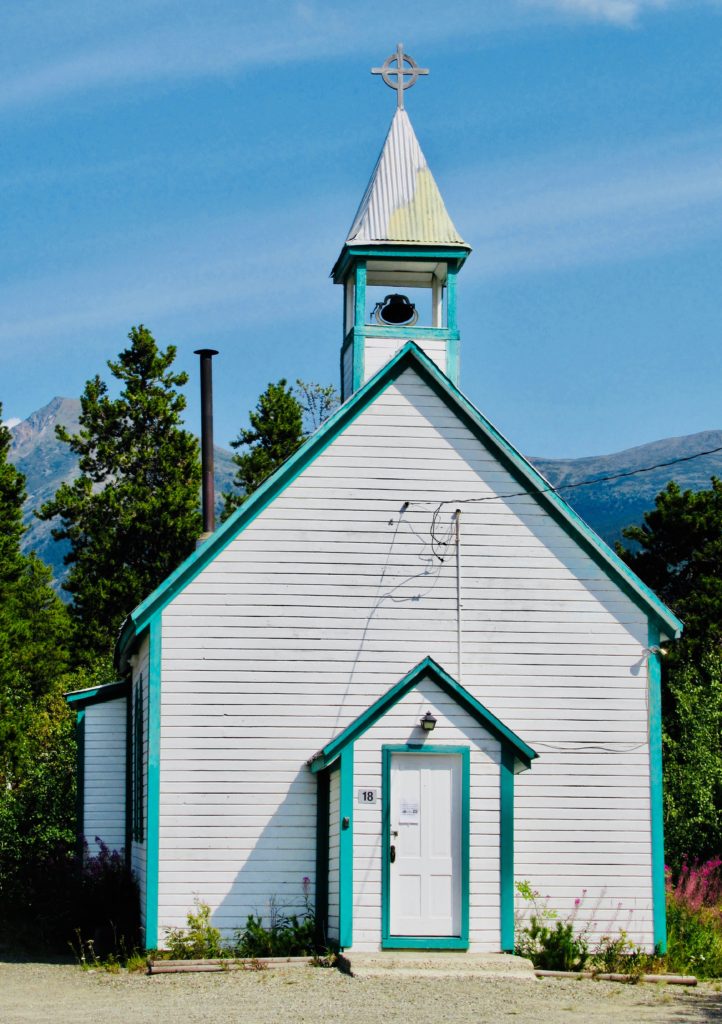Stepping outside the tourist core and exploring Carcross, Yukon on foot unlocks stories of the past. Wander along as we search for ghosts, trip along in the aftermath of the Klondike Gold Rush and follow the boom and bust cycle of life in Canada’s North.
Disclosure: This post contains affiliate links. If you buy something from one of our affiliates, we receive a small commission at no extra charge to you. Thanks for helping to keep our blog up and running!

Table of Contents
Exploring Carcross, Yukon
Thousands of visitors step off the vintage cars of the White Pass & Yukon Route Railway each season.
Many will grab an ice cream from the shop next door to Matthew Watson’s General Store (one of the Yukon’s longest operating businesses) and stroll through the Commons and admire its colourful totems and artisanal shops.
Some may want to follow the footsteps of the Duke and Duchess of Cambridge on their royal visit in 2016.

A few will snap photos of the 125-metre swing railway bridge built in 1900.
Others will appreciate the sternwheeler Tutshi interpretive site, stopping to read the signs that explain that the ship was built for tourism along the Yukon’s Southern Lakes before becoming a freighter for mining communities until roads took over in the 1940s.
If time, some might grab a quick snack at the sourdough bakery before they all join back together and hop on the bus to Skagway and their waiting cruise ship.
Been there, done that.
But have they, really?
Did you know? Carcross was originally called Caribou Crossing for the herds that would cross the narrows between Bennett and Nares Lakes.
Starting A Walk About
I love history. It is the stories that tell the past. After picking up a copy of the excellent Historic Sites Carcross Walking Tour pamphlet (available for free from the Visitor Centre), I set off. I am on a hunt for his… and her story.
Skookum Jim’s house, anchoring the Carcross Commons, now houses the Parks Canada interpretive centre. It’s busy.
First built in 1899, the original home collapsed during renovations in 1987. Skookum Jim (Keish) was born in 1855 in Tagish near Lake Bennett. His mother was Tagish from the Wolf Clan. His father was a Tlingit man from the Crow clan.
As a young man, Keish worked as a packer on the Chilkoot Trail. It was here he got the nickname, Skookum Jim.
In 1896, Skookum Jim was one of the major players in the discovery of gold near Dawson City. Today, historic photos of the area during the Klondike Gold Rush cover the walls.
A Ghost, The Mail Room and a Mining Magnate Gone Bust
A few people are reading the signs around the S.S. Tutshi Memorial as a I pass by.
Across the street, carpenters are hard at work restoring the 1910 Caribou Hotel Building.
No one else appears to be looking in the third-floor windows for the ghost of Bessie Gideon. She died on Oct 27, 1933 and it is said that she’s been seen putting bubbles in the bath and looking out the windows.
Strolling past the general store, I stop to admire the little log house across the street. Moose and caribou antlers hang off the peak of the roof. A rusty shovel, gold pan and pick axe hang above the doorway.
Local prospector Jack Pooley built the cabin in 1903 right next to the railway bridge.
I’m thinking he must have liked the sounds of trains.

Continuing the Tour
Down the street is the Carcross Post Office.
The first post office opened on this site in 1902. It served as a telegraph office and Northwest Mounted Police detachment.
The original building was replaced with today’s structure in 1910.
Although there are older post office buildings in Canada, this is the oldest continuously running one.

The post office is closed today, but I peek in the windows.
I wonder if the wooden floors creak as nicely as the ones in the general store.
A path leads down to Lake Bennett’s sandy shores and the pedestrian bridge, but I’ll save that for later.
No one else is on the street as I snap a photo of the crisscross railing on the porch of the Phelps cabin right beside the lakeshore path.
It was originally built in 1905 for the president of the Conrad Consolidated Mining Company.
John Howard Conrad went bankrupt in 1912. He deeded this cabin to his lawyer, Willard Phelps, in payment for his services.
The Phelps family still own the property today.

Watson’s Row and A Tiny Home
Down the road, a faded red 1950s Chevy pickup sits outside one of several properties originally owned by entrepreneur Matthew Watson.
Next door, the Jones cabin was built in 1938 with logs from a home in Conrad City.
Quite a few of the historic homes in Carcross came from the abandoned Conrad City on the Windy Arm of Tagish Lake.

A little cabin with bright yellow trim on the windows catches my eye.
It was built in 1905 by a man named Kennedy and became one of Matthew Watson’s rentals in 1910.
But it’s the small sign outside the doorway that tells the biggest story.
It reads: “Miss Matthews Cabin.”
Anglican missionary Ruth Matthews was well-known and loved in the community during the 1950s. Miss Matthews rented this sunny gem during her stay in Carcross.

The other somewhat historic, but completely humorous, home I couldn’t resist is just down the street.
Arnulf “Arne” Ormen was a true original. Arne built a tiny home for his retirement years in the 1960s. He wanted a place where he could light the fire without getting out of bed.
The cabin was so small that the tall Scandinavian couldn’t even stand up straight inside.
Across the Tracks
Heading back to the pedestrian bridge, I cross it and the railway tracks on the south bank to discover several more historic homes transported down the lake from Conrad City.
No one is walking the dusty road.
Many of the homes along the water’s edge are mere shells of their former selves.

Without the guide, I wouldn’t have been able to catch a glimpse of the numerous stories held within the walls of Peter Johns cabin or Dora Wedge’s house or any of slowly disappearing historic homes.
Bishop Bompas’s log cabin started out as a bunkhouse for a development company in the early 1900s. It became the bishop’s home, a school, a church and went back to a private home until the last occupant’s moved out in the 1980s.
The building is slowly being lost to time and the elements, but for the moment, it still stands as testament to another time.
My walk is almost done.
I head back to visit Saint John the Baptist Catholic Church, moved from Conrad City in 1939. Saint Saviours Anglican Church was built in 1904 on the south side of the narrows near Bishop Bompas’s cabin. The church moved to its present location near the Commons in 1917.

(Photo: Megan Kopp)
Hiking Above Carcross to Connect the Dots
Firstly, hike to Nares Mountain is the tall peak across Nares Lake.
A hiking trail leads up the left shoulder.
It offers spectacular overviews of Carcross from just a short distance up. Continuing to the summit is a steep, but spectacular four-kilometre climb.
At the summit, there are amazing views of the alpine slopes of Brute, Montana and Caribou Mountains.
It is possible to look beyond Carcross to the far reaches of Bennett Lake and the Windy Arm of Tagish Lake, where Conrad City once flourished.

(Photo: Brad Kopp)
This hike (trail access and route description can be found at Yukonhiking.ca) is the perfect way to connect the dots between the stories of turn-of-the century Carcross.
It’s a perspective that many people don’t get a chance to see.
What are you waiting for?
You can’t say been there, done that until you really have been there and done that!
Looking for more Yukon adventures?
Check out these posts:
- Nisutlin River Canoe Trip | Yukon
- Exploring Tombstone Territorial Park, Yukon Canada
- Hiking in Tombstone Territorial Park, Yukon Canada
- Yukon Winter Getaway
- Yukon Adventures: Finding Stories Tall & True
- Backpacking in the Yukon: Bock’s Lake
- Taking Time in Teslin, Yukon
Resources:



Leave a Reply